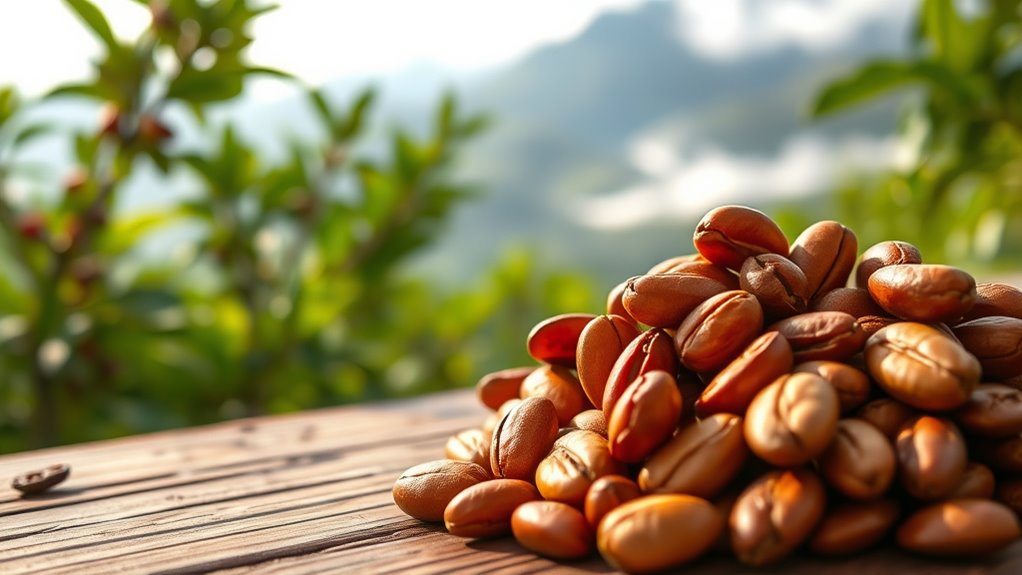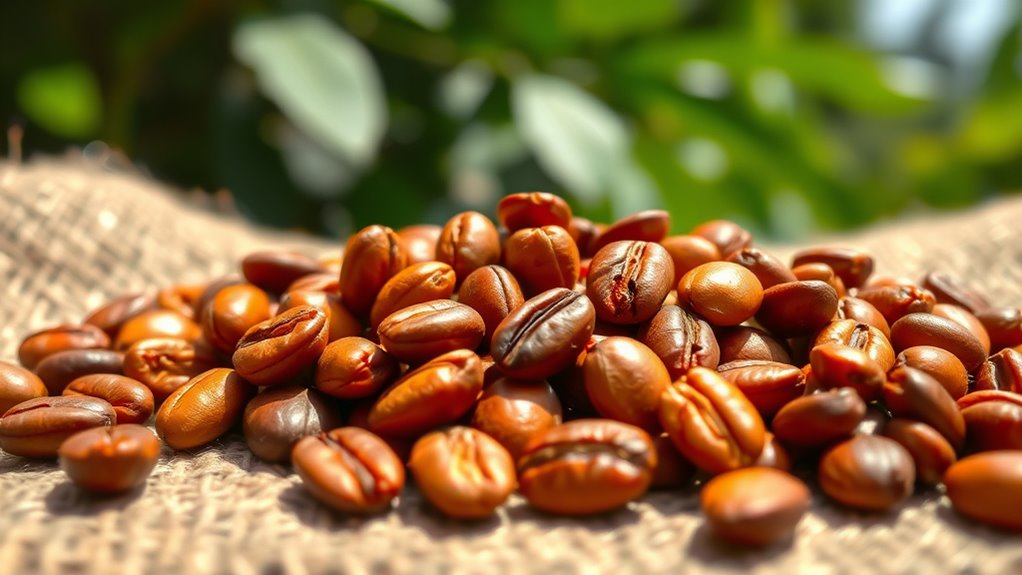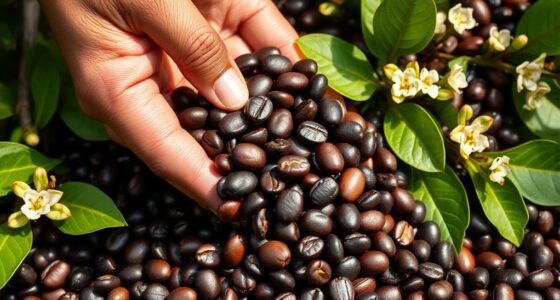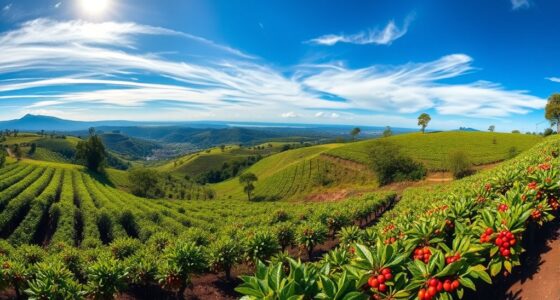Panama put specialty coffee on the map by cultivating and promoting Geisha beans, known for their exceptional aroma and complex flavor notes. The country’s focus on sustainable farming practices, like shade-grown and organic methods, has elevated its reputation globally. Despite resource challenges, Panama’s dedication to quality has earned international recognition and awards. If you want to discover how these efforts transformed Panama into a coffee powerhouse, keep exploring.
Key Takeaways
- Panama’s Geisha beans gained global recognition through award-winning quality and unique aromatic profiles, elevating the country’s reputation in specialty coffee.
- The adoption of sustainable, eco-friendly farming practices like shade-grown cultivation and organic fertilization enhances bean quality and ecological health.
- Panama’s focus on meticulous cultivation and quality control helped position Geisha as a premium, sought-after coffee variety worldwide.
- Strategic marketing and international recognition fueled demand, putting Panama on the map as a leading producer of high-end specialty coffee.
- Commitment to environmental stewardship and ethical practices fostered a sustainable industry, reinforcing Panama’s status in the global specialty coffee market.

If you’ve ever tasted coffee that’s truly exceptional, you’ve likely encountered Panama’s Geisha beans. Renowned for their unique aromatic profile and complex flavor notes, Geisha coffee has become a symbol of Panama’s rise in the specialty coffee world. This variety isn’t just about flavor; it represents a commitment to sustainable farming practices that prioritize environmental health and local communities. Many farmers in Panama adopt eco-friendly methods, such as shade-grown cultivation and organic fertilization, ensuring that their practices preserve the delicate ecosystems of the region. This focus on sustainability not only elevates the quality of the beans but also aligns with the values of discerning coffee enthusiasts who seek ethically produced products.
However, producing and exporting Geisha beans isn’t without its challenges. The delicate nature of these beans demands meticulous care throughout the entire process, from planting to processing. Farmers often face difficulties balancing the high standards required for Geisha with the realities of sustainable farming—limited access to resources, fluctuating climate conditions, and the need for specialized knowledge. These factors contribute to the overall complexity of cultivating Geisha coffee, making it a labor-intensive endeavor. When it comes to export challenges, Panama’s Geisha producers must navigate a competitive global market that values rarity and quality. Logistics and transportation can be tricky, especially given the region’s remote locations and the need to maintain freshness during transit. Additionally, international trade regulations and fluctuating tariffs can complicate the export process, requiring farmers and exporters to develop resilient strategies to guarantee their prized beans reach markets intact. The emphasis on quality control plays a crucial role in overcoming these hurdles and ensuring the beans meet international standards.
Despite these hurdles, Panama’s dedication to quality and innovation has propelled its Geisha beans onto the world stage. The country’s coffee origin has become synonymous with excellence, attracting awards and recognition that boost demand worldwide. This global appreciation fuels local farmers’ motivation to uphold sustainable practices, even when faced with export challenges. By emphasizing environmental stewardship and sustainable farming, Panama has successfully positioned itself as a leader in specialty coffee. For you as a consumer, that means enjoying a cup of Geisha isn’t just about flavor; it’s about supporting a community that values sustainable farming and overcomes logistical obstacles to bring you one of the most extraordinary coffees on the planet.
Frequently Asked Questions
What Are the Primary Growing Regions for Geisha Beans in Panama?
You’ll find geisha beans primarily in Panama’s high-altitude regions like Boquete and Volcán. These areas benefit from altitude cultivation, which enhances bean complexity and flavor. Microclimate effects, such as cooler temperatures and unique weather patterns, create ideal conditions for growing geisha beans. These regions’s combination of altitude and microclimate effects helps produce the distinctive, sought-after flavors that put Panama’s geisha coffee on the map.
How Does Panama’s Climate Influence Geisha Coffee Flavor Profiles?
You might think climate’s just about sunny days, but in Panama, it’s more like a flavor wizard. Microclimate variations and altitude effects create a coffee playground, shaping Geisha beans’ unique profiles. Cooler mountain air and diverse microclimates develop complex, floral, and fruity notes. So, your coffee’s flavor isn’t just luck—it’s Panama’s climate working overtime, turning each cup into a delightful adventure. Cheers to nature’s coffee artistry!
What Are the Main Challenges Faced by Geisha Coffee Farmers in Panama?
You face several challenges as a geisha coffee farmer in Panama. Climate adaptation becomes vital since unpredictable weather impacts your crop quality and yield. Additionally, labor challenges, like finding skilled workers during harvest, strain your resources. You must continuously adjust your practices to withstand climate shifts and guarantee a steady labor force, all while maintaining the exceptional quality that makes geisha beans sought after worldwide.
How Has Panamanian Geisha Impacted Global Coffee Prices?
You might think global coffee prices stay steady, but Panamanian Geisha has markedly influenced market price fluctuations. Its rarity and high quality drive up prices, impacting the export market and setting new standards. This premium status pushes up the overall market value, encouraging other regions to improve quality. As a result, Panama’s Geisha shapes global coffee trends, making specialty beans more desirable and affecting worldwide pricing dynamics.
Are There Sustainable Practices Unique to Panama’S Geisha Coffee Production?
You’ll find that Panama’s Geisha coffee producers focus on sustainable farming and eco-friendly practices. They often use shade-grown methods, which help preserve local ecosystems and promote biodiversity. Many farms implement water conservation techniques and organic fertilizers, reducing environmental impact. These sustainable approaches guarantee the coffee’s high quality while protecting the land for future generations. By prioritizing eco-conscious methods, Panama’s Geisha beans set a global example for responsible coffee production.
Conclusion
As you explore Panama’s Geisha beans, you’ll discover a treasure that put the country on the global coffee map. Their unique flavor profile is like a rare gem, shining brightly among other coffees. Panama’s dedication to quality and innovation has turned these beans into a symbol of excellence. So, next time you sip that cup, remember you’re tasting a piece of coffee history—crafted with passion and as exquisite as a work of art.









